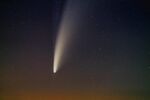Astronomy:Radcliffe wave
The Radcliffe wave is a neighbouring coherent gaseous structure in the Milky Way, dotted with a related high concentration of interconnected stellar nurseries. It stretches about 8,800 light years.[1][2] This structure runs with the trajectory of the Milky Way arms.[3][4]
It lies at its closest (the Taurus Molecular Cloud) at around 400 light-years and at its farthest about 5,000 light-years (the Cygnus X star complex) from the Sun, always within the Local Arm (Orion Arm) itself, spanning about 40% of its length and on average 20% of its width.[5][4] Its discovery was announced in January 2020, and its proximity surprised astronomers.[1][6]
Formation
Error: No valid link was found at the end of line 6.
Scientists do not know how the undulation of dust and gas formed. It has been suggested that it could be a result of a much smaller galaxy colliding with the Milky Way, leaving behind "ripples", or could be related to dark matter.[1][7] Inside the dense clouds, gas can be so compressed that new stars are born.[2] It has been suggested that this may be where the Sun originated.[1]
Many of the star-forming regions found in the Radcliffe wave were thought to be part of a similar-sized but somewhat helio-centric ring which contained the Solar System, the "Gould Belt". It is now understood the nearest discrete relative concentration of sparse interstellar matter instead forms a massive wave.[1][2]
Discovery
The wave was discovered by an international team of astronomers including Catherine Zucker and João Alves.[8][4] It was announced by co-author Alyssa A. Goodman at the 235th meeting of the American Astronomical Society, held at Honolulu[9] and published in the journal Nature on 7 January 2020.[10] The discovery was made using data collected by the European Space Agency's Gaia space observatory.[11]
The wave was invisible in 2D, requiring new 3D techniques of mapping interstellar matter to reveal its pattern.[2][11][9] The proximity of the wave surprised astronomers.[1][6] It is named after the Radcliffe Institute for Advanced Study in Cambridge, Massachusetts, the place of study of the team.[11]
Overview
The Radcliffe wave contains four of the five Gould Belt clouds, the:
The cloud not within its scope is the Rho Ophiuchi Cloud complex, part of a linear structure parallel to the Radcliffe wave.
Other structures in the wave, further from the local star system, are Canis Major OB1, the North America Nebula and Cygnus X.[4]
The mass of this structure is on the scale of [math]\displaystyle{ \geq3\times10^6 }[/math] M☉. It has a length of 8,800 light-years (2,700 parsecs) and an amplitude of 520 light-years (160 parsecs). The Radcliffe wave occupies about 20% of the width and 40% of the length of the local arm (Orion Arm). The latter is more dispersed as to its interstellar medium than the wave and has further large star-forming regions such as Monoceros OB1, California Nebula, Cepheus Far, and Rho Ophiuchi.[4]
See also
- Antlia 2, another giant ripple across the Milky Way's disc found in data from the Gaia space telescope
- List of nearby stellar associations and moving groups
- Great Rift
- Serpens-Aquila Rift
References
- ↑ 1.0 1.1 1.2 1.3 1.4 1.5 "Astronomers discover huge gaseous wave holding Milky Way's newest stars". The Guardian. 7 January 2020. ISSN 0261-3077. https://www.theguardian.com/science/2020/jan/07/astronomers-discover-huge-gaseous-wave-holding-milky-ways-newest-stars.
- ↑ 2.0 2.1 2.2 2.3 Rincon, Paul (7 January 2020). "Vast 'star nursery' region found in our galaxy". https://www.bbc.com/news/science-environment-51021704.
- ↑ Brandon, Specktor (7 January 2020). "Mysterious 'Wave' of Star-Forming Gas May Be the Largest Structure in the Galaxy". https://www.livescience.com/radcliffe-wave-largest-milky-way-structure.html.
- ↑ 4.0 4.1 4.2 4.3 4.4 Alves, João; Zucker, Catherine; Goodman, Alyssa A.; Speagle, Joshua S.; Meingast, Stefan; Robitaille, Thomas; Finkbeiner, Douglas P.; Schlafly, Edward F. et al. (January 2020). "A Galactic-scale gas wave in the Solar Neighborhood" (in en). Nature 578 (7794): 237–239. doi:10.1038/s41586-019-1874-z. PMID 31910431. Bibcode: 2020Natur.578..237A.
- ↑ Brandon, Specktor (7 January 2020). "Mysterious 'Wave' of Star-Forming Gas May Be the Largest Structure in the Galaxy". https://www.livescience.com/radcliffe-wave-largest-milky-way-structure.html.
- ↑ 6.0 6.1 Osborne, Hannah (7 January 2020). "Something appears to have collided with the Milky Way and created a huge wave in the galactic plane". https://www.newsweek.com/milky-way-huge-wave-collision-1480799.
- ↑ "Something Appears to Have Collided with the Milky Way and Created a Huge Wave in the Galactic Plane" (in en). 2020-01-08. https://www.radcliffe.harvard.edu/news/in-news/something-appears-have-collided-milky-way-and-created-huge-wave-in-galactic-plane.
- ↑ McIntosh, Bennett (7 January 2020). "An Interstellar Ribbon of Clouds in the Sun's Backyard". https://harvardmagazine.com/2020/01/intergalactic-radcliffe-wave.
- ↑ 9.0 9.1 Strickland, Ashley. "Astronomers discover giant wave-shaped structure in the Milky Way". CNN. https://www.cnn.com/2020/01/07/world/new-milky-way-map-scn/index.html.
- ↑ "New map of Milky Way reveals giant wave of stellar nurseries". https://phys.org/news/2020-01-milky-reveals-giant-stellar-nurseries.html.
- ↑ 11.0 11.1 11.2 Dunn, Marcia (8 January 2020). "Titanic wave of star-forming gases found in Milky Way". Associated Press. ISSN 0447-5763. https://www.japantimes.co.jp/news/2020/01/08/world/science-health-world/titanic-wave-star-forming-gases-found-milky-way/.
External links
- Alves, João; Zucker, Catherine; Goodman, Alyssa A.; Speagle, Joshua S.; Meingast, Stefan; Robitaille, Thomas; Finkbeiner, Douglas P.; Schlafly, Edward F. et al. (2020). "A Galactic-scale gas wave in the solar neighborhood". Nature 578 (7794): 237–239. doi:10.1038/s41586-019-1874-z. PMID 31910431. Bibcode: 2020Natur.578..237A.
- Interactive map of the Radcliffe wave on the sky
- The Radcliffe Wave informational site created by Harvard University
 |





